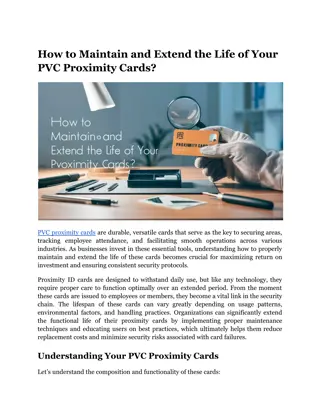
What is an ISO PVC Proximity Card_
Learn what ISO PVC proximity cards are, how they work, and why they're essential for secure access systems.n
Download Presentation

Please find below an Image/Link to download the presentation.
The content on the website is provided AS IS for your information and personal use only. It may not be sold, licensed, or shared on other websites without obtaining consent from the author. Download presentation by click this link. If you encounter any issues during the download, it is possible that the publisher has removed the file from their server.
E N D
Presentation Transcript
What is an ISO PVC Proximity Card? We're in an era where a simple wave of a card can grant you entry to secure areas, clock you in for work, or even process small payments. This technological leap forward is largely thanks to the development and widespread adoption of contactless smart cards. Among these modern marvels, the ISO PVC Proximity Card (check out the ones from Bristol ID Technologies) stands out as a popular choice for businesses, educational institutions, and government facilities worldwide. These unassuming pieces of plastic pack a surprising amount of technology and versatility into a form factor no larger than a standard credit card. But what exactly makes these cards tick? How do they work, and why have they become so prevalent in our daily lives?
What Exactly Is an ISO PVC Proximity Card? At its core, an ISO PVC Proximity Card is a type of contactless smart card used primarily for access control and identification. But what sets it apart from other cards in your wallet? Key Features: Size: Identical to a standard credit card (CR80 size) Material: Made from durable polyvinyl chloride (PVC) plastic Thickness: Typically 0.03 inches (0.76 mm) Technology: Uses Radio Frequency Identification (RFID) for contactless communication Frequency: Operates at 125 kHz Read Range: Up to 50 cm (20 inches) These cards are designed to meet the ISO/IEC 7810 standard for identification cards, ensuring consistency and compatibility across various systems. The Inner Workings: How Proximity ID Cards Function To understand the magic behind proximity ID cards, let's break down their key components: 1. Antenna: A coil of wire that receives and transmits radio signals 2. Capacitor: Stores energy from the reader's radio field 3. Integrated Circuit (IC): Contains the user's ID number and other relevant data When you wave your card near a reader, here's what happens: 1. The reader emits a radio field 2. The card's antenna absorbs energy from this field 3. This energy powers up the IC
4. The IC transmits stored data back to the reader 5. The reader processes the information and grants (or denies) access All of this happens in a fraction of a second, making PVC proximity cards incredibly convenient for users. Why Choose Proximity Smart Cards? Proximity smart cards offer several advantages over traditional key-based or magnetic stripe systems: Convenience: No need to remove the card from your wallet or purse Durability: PVC material resists everyday wear and tear Versatility: Can be combined with visual ID and other technologies Customization: Printable surface for photos, text, and graphics HID Access Control Cards: A Popular Choice When it comes to proximity card manufacturers, HID Global is a name that often comes up. Their HID access control cards are widely used across various industries. Here's why: Reliability: Known for consistent performance Compatibility: Works with a wide range of access control systems Security Features: Options for enhanced encryption and anti-counterfeiting measures Spotlight on HID 37 Bit Proximity Cards One popular format is the HID 37 bit proximity cards. This format offers: Unique Identification: Each card has a unique ID number Facility Code: Allows for organization-specific grouping
Large Number of Combinations: Supports up to 65,535 facility codes and 524,288 card numbers per facility code Feature Benefit Unique ID Enhances security by preventing duplicate cards Facility Code Simplifies card management for large organizations Large Combinations Scalable for growing businesses Applications: Where PVC Proximity Cards Shine These versatile cards find use in various settings: 1. Access Control: Secure entry to buildings or restricted areas 2. Time and Attendance: Track employee work hours accurately 3. Identification: Serve as employee or student ID cards 4. Parking Management: Control access to parking facilities 5. Cashless Payments: Some systems allow for small transactions Choosing The Right Card: Factors to Consider When selecting PVC proximity cards for your organization, keep these points in mind: 1. Security Level: While convenient, 125 kHz technology is less secure than newer high-frequency options 2. Compatibility: Ensure the cards work with your existing or planned access control system 3. Customization Needs: Determine if you require additional features like magnetic stripes or printable surfaces 4. Budget: Consider both initial costs and long-term scalability 5. Environmental Factors: PVC cards are durable but may not be suitable for extremely harsh conditions
The Future of Access Control While ISO PVC Proximity Cards continue to be widely used, the industry is evolving. Here are some trends to watch: Multi-Technology Cards: Combining proximity technology with smart chips or NFC for enhanced functionality Mobile Credentials: Using smartphones instead of physical cards Biometric Integration: Combining card-based access with fingerprint or facial recognition Cloud-Based Systems: Managing access control through secure, remote platforms Making the Most of Your Proximity Smart Card System To maximize the benefits of your proximity smart card system: 1. Train Users: Ensure all cardholders understand how to use and care for their cards 2. Regular Audits: Periodically review access permissions and deactivate lost or unnecessary cards 3. Integrate Systems: Connect your access control system with other security measures for a comprehensive approach 4. Stay Updated: Keep your readers and software up-to-date to maintain security and functionality 5. Consider Multi-Factor Authentication: For high-security areas, combine card access with additional verification methods Smarter Access Control
These Proximity Cards have become a cornerstone of modern access control systems. Their blend of convenience, durability, and versatility makes them an attractive option for businesses of all sizes. While proximity card manufacturers like Bristol ID Technologies offer a range of options, the key is finding the right balance of security, functionality, and cost for your specific needs. By choosing wisely and implementing thoughtfully, you can create an access control system that not only enhances security but also improves efficiency and user satisfaction. Site Article: What is an ISO PVC Proximity Card?






















